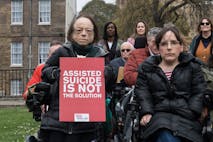
Christian college allows pro-life club after resolving 'misunderstanding'
Bridget Sielicki
·
A Belgian woman was set to be euthanized. Then loved ones heard her screaming.
The euthanasia program in Belgium has come under fire again, following news that a woman was suffocated with a pillow after the cocktail of drugs administered to her failed to end her life.
Le Soir, a European media outlet, reported that Alexina Wattiez, who was just 36 years old, sought euthanasia after being diagnosed with terminal cancer. In 2021, her doctor informed her that she would not survive for another year, and by March of 2022, her health was deteriorating.
Christophe Stulens, Wattiez’s partner, was there when she died, along with his 15-year-old daughter, Tracy. A doctor and two nurses came to the home that the three shared to carry out the euthanasia. “After a short night’s sleep, I was woken up by a nurse who told me that Alexina was doing very badly,” Stulens said. “Then the doctor took some syringes and we were asked if we wanted to say goodbye.”
Stulens and his daughter were told to wait outside, so they went onto the terrace, but what they thought would be a peaceful death quickly turned horrific: they heard screaming.
“I recognized her voice,” he said. “Afterwards we saw her lying on the bed with her eyes and mouth open.”
READ: Euthanasia organization tells elderly they’ll have a ‘bad death’ without assisted suicide
An autopsy was performed, and found that Wattiez died of asphyxiation. Allegedly, the nurses took turns using a pillow to suffocate her. “Alexina wanted to sleep peacefully, but apparently there were too few resources,” Stulens said. The Public Prosecution Service of Liège has now opened a murder investigation, while Stulens is suing.
A lawyer for the family, Maître Renaud Molders-Pierre, said they are not looking to get money.
Article continues below
Dear Reader,
Have you ever wanted to share the miracle of human development with little ones? Live Action is proud to present the "Baby Olivia" board book, which presents the content of Live Action's "Baby Olivia" fetal development video in a fun, new format. It's perfect for helping little minds understand the complex and beautiful process of human development in the womb.
Receive our brand new Baby Olivia board book when you give a one-time gift of $30 or more (or begin a new monthly gift of $15 or more).
“Their goal is not to demand sanctions but to provoke a debate and that this type of affair never happens again,” he said. “Could you imagine that your mother or your wife could end up suffocated by a cushion as part of her end of life? I think no one can conceive and imagine that.”
Sudinfo, a Belgian media outlet, was able to speak to someone on behalf of the doctor. “The nurses were distraught and they called the doctor, my client,” Serge Douin said on behalf of the doctor, adding, “he only injected products to relieve the patient’s suffering.”
The incident was quickly condemned. “What happened is not euthanasia,” Belgian politician and doctor Jacques Brotchi told RTL Info. “Such a definition of this terrible situation devalues the gesture of euthanasia, which accompanies a person to the end without pain.”
The drugs used in assisted suicide are often the same used for executions, and they are frequently known to fail. Additionally, while the process of dying may look peaceful, in reality, there is a serious possibility of severe pain.
As Dr. Joel Zivot, an associate professor of anesthesiology and surgery at the Emory School of Medicine, has previously explained, “The death penalty is not the same as assisted dying, of course. Executions are meant to be punishment; euthanasia is about relief from suffering. Yet for both euthanasia and executions, paralytic drugs are used. These drugs, given in high enough doses, mean that a patient cannot move a muscle, cannot express any outward or visible sign of pain. But that doesn’t mean that he or she is free from suffering.”
In fact, the lungs may fill with fluid, causing the patient to essentially drown while he or she is paralyzed.
“Advocates of assisted dying owe a duty to the public to be truthful about the details of killing and dying,” Zivot continued. “People who want to die deserve to know that they may end up drowning, not just falling asleep.”

Live Action News is pro-life news and commentary from a pro-life perspective.
Contact editor@liveaction.org for questions, corrections, or if you are seeking permission to reprint any Live Action News content.
Guest Articles: To submit a guest article to Live Action News, email editor@liveaction.org with an attached Word document of 800-1000 words. Please also attach any photos relevant to your submission if applicable. If your submission is accepted for publication, you will be notified within three weeks. Guest articles are not compensated (see our Open License Agreement). Thank you for your interest in Live Action News!

Bridget Sielicki
·
International
Angeline Tan
·
International
Cassy Cooke
·
International
Cassy Cooke
·
International
Bridget Sielicki
·
International
Angeline Tan
·
Analysis
Cassy Cooke
·
International
Cassy Cooke
·
International
Cassy Cooke
·
Politics
Cassy Cooke
·
Pop Culture
Cassy Cooke
·